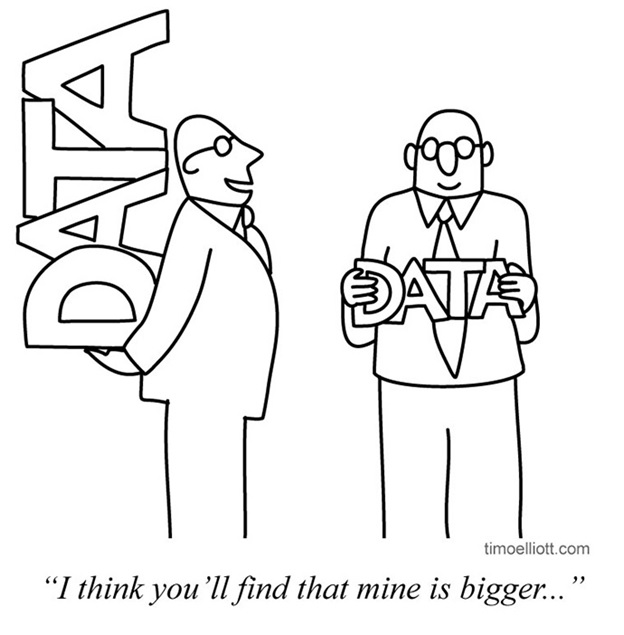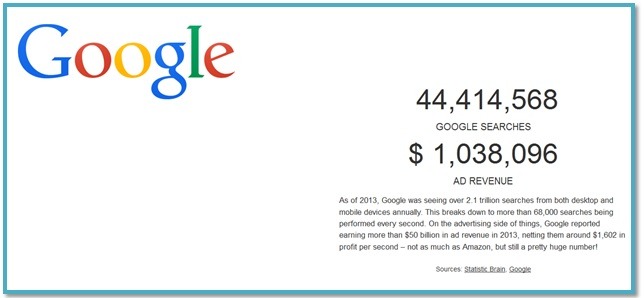As our media lives continue to evolve, we know the numbers for digital and social usage are off the charts. But if you really want to get a sense for just how mind-boggling the stats are for the platforms, gadgets, and devices that we use, look no further than this link:
WebpageFX – The Internet in Real Time
Yes, the folks at WebpageFX, an international web marketing firm, have come with the perfect tool to give us a sense of appreciation of what we’re doing in real time on the World Wide Web.
And this by-the-numbers visualization is nothing short of astonishing. And what’s just as amazing is the “real-time” format that simulates this incredible data. Like the National Debt Clock that was installed in Midtown Manhattan back in 1989 by real estate executive Seymour Durst, there is something very compelling about seeing a virtual real-time look at our digital usage.
Consider this:
There are one BILLION video views on Facebook every day.
Overall 800 apps are downloaded PER SECOND on iPhones each day.
There are 93 million selfies taken EVERY SINGLE DAY using Android handsets.
And right now, you’re reading one of 42.6 MILLION monthly posts on WordPress blogs.
From Skype minutes to Amazon dollars spent to Google searches to Kickstarter dollars pledged, the daily comings and goings on the web are catalogued here. Not to mention the hours watched on YouTube and Netflix, as well as the hours streamed on Pandora and Spotify.
So as I was scrolling through these astounding numbers that catalog our changing media lives, I started wondering what radio listening might look like in the same format.
How many hours do Americans actually spend listening to radio every day? And how would tracking those numbers via streams and terrestrial broadcasts, from sources like Nielsen meters and diaries as well as data from companies like Triton, chronicle radio’s daily impact on people’s lives?
From public radio to formats as diverse as Classic Hip-Hop, All News, and Christian, from Classic Rock to CHR, radio listening would have to be in the millions of hours per day.
A live plug-in like WebpageFX has built could live on the RAB’s website, along with the sites of thousands of stations in America as a reminder that radio – despite the digital disruption – is still an integral part of the fabric of people’s lives every single day.
And like the Google screen cap above, maybe daily ad revenue spent would be another way to express the power of radio as a marketing tool that has endured.
There’s always a lot of industry talk about telling radio’s story in a more compelling and vivid way.
So what are we waiting for?
Thanks to Lori Lewis for bringing this great web tool to my attention. And to Timo Elliott for permission to use his wonderful cartoon.
- What To Do If Your Radio Station Goes Through A Midlife Crisis - April 25, 2025
- A 2020 Lesson?It Could All Be Gone In A Flash - April 24, 2025
- How AI Can Give Radio Personalities More…PERSONALITY - April 23, 2025






Can’t Wait! Real proof of Audio Measurement and on-going importance of Radio as THE great connector for all media…”As long as folks can hear.”
Thanks again, Fred. Encourage all to Vote for Refreshed Content.
Thanks for the thumbs up for radio, Clark.
It is disheartening to see an article like this in 2015. Webpagefx.com was acquired in 2002, and ignored by radio as has nearly every digital tool.
We’ve hear talk, plenty of talk. Each year I ask “what is it you’ve heard discussed at this NAB/RAB Radio Show that’s implemented when you get back to the station?” Guess the answer.
“I started wondering what radio listening might look like in the same format.” Fred, we would have found out years ago if someone in the executive suites of radio had brought in people who knew data, digital, and how to make the backend work for radio. I gave Erica Farber a report about data metrics and radio online at the Cleveland RAB conference – I believe the year was 2005. Never heard anything back, not even a “thank you.”
This is a picture of one of my clients old tracking sheets. It goes pages deep. They are not a Triton Digital subscriber but represent one of dozens of non-subscribers. The large numbers and data tracking that’s grown, and been refined for nearly a decade, are staggering: https://www.audiographics.com/demo/stats.png
You want radio to compete with data? Get a good statistician and put them to work doing things that people in radio can’t possible understand.
As for your “There’s always a lot of industry talk about telling radio’s story in a more compelling and vivid way. So what are we waiting for?”
For well over a decade I’ve been waiting for somebody in the radio industry to listen, then act. Everyone wants to talk. Few listen. Nobody gets to that “act” part. That’s the hang-up I don’t believe radio will ever get past.
Ken, it’s a sad commentary on the industry when actions rarely speak louder than words. Your data demonstrate that painting a picture with numbers could be an effective antidote to the growing number of people who mistakenly claim that “No one listens to the radio anymore.” Amazingly, it’s not too late and there are great stories to be told. That’s why I asked the question, and hopefully, your prediction that no one has the stones to act doesn’t come true. Thanks for contributing to the conversation.
This is a very intriguing idea! As you know the RAB collects lots and lots of big data and does our best to get it in the hands of as many people as possible.
Radio has a very compelling story and the more of us telling the story each and every day the more success we will have in getting the marketplace to accept the reality of Radio’s incredible strength.
Was surprised to read Ken Dardis’s comment. I am thinking he may have mixed me up with someone one else as I didn’t join the RAB until 2012. Ken, I hope you will accept my apology if somehow I didn’t follow up with you.
Action does speak louder than words and we are moving as fast as we can.
Erica, thanks for the comment and the perspective. There are many people in and out of radio who want to see the business compete more aggressively in the growing audio space. Good to see your reaction to this presentation style is positive. As you spend time with the “powers that be,” hopefully, this can be an idea of how to better visualize and communicate just how powerful radio listening really is. Erica, yours is not an easy task as everyone in the industry knows too well. Thanks for fighting the good fight, and let’s see if we can move this ball down the field.
Erica: Thank you for that quick reply.
I am sure it was you, in the year that RAB held its convention in Cleveland. The 50+ page report was handed to you after Steven Van Zandt gave his talk, but this is besides the point. Radio has not made movement towards digital despite constant urgings. It continues to talk and follow things which are easy to copy – SweetJack/Groupon, iHeartRadio/Pandora, using the term “digital” without a true deep dive into what it means.
I suggest a reading of “Competing on Analytics” (Thomas Davenport/Jeanne Harris). Published in 2007, it gives a solid view of what multiple companies pursue when using the term “digital.” – https://www.amazon.com/Competing-Analytics-The-Science-Winning/dp/1422103323
The industry announces many initiatives without outside help – and that is the problem. How many of these succeeded?
LMiV
Network Radio Compliance Council
Radio Communicators Group
Radio 2020
Radio Heard Here
The HD Radio Alliance
Radio. You Hear It Here First
Buy from FM
Less is More
Radio Creative Resource Group
Format Lab
TotalRadius
HD Radio University
WhyRadio?
Blink Ads
The International Broadcasters IdeaBank
freeradioonmyphone.org
Erica… what I most likely have mixed up is your position at Radio & Records with RAB.
At the time, I was trying to get the report into the hands of someone in a position to affect radio’s future.
You are due an apology for that error.
Ken Dardis
Hmmm. I think the radio sales implications for big data are limited. Advertisers and would be advertisers respond to specific solutions to their specific challenges, not broad numbers referencing how many people are consuming this or that on a national level.
I’ve said this before and probably will again – radio’s sales problem is not that it doesn’t tell its story enough or well enough, or brag about its reach numbers. Radio’s sales problem is conversely, that it doesn’t listen to its client/prospects stories enough, being too focused on its inside sense of what advertisers should, but don’t care about.
The problem has two roots. 1) Radio’s long standing misconception that sweeping generalizations about its size and reach are important to people with business challenges. They never were and still aren’t. 2) Radio’s progressive dumbing down of its sales efforts with lower pay and restrictive non competes that send most talented customer focused sales people to other industries. I wonder how much of radio’s lost revenue is due to this.
Last but maybe not least, measuring body parts is always risky, particularly when the measured parts are suffering from shrinkage…with apologies to George Costanza. Radio should IMO stop worrying about how big it is and start focusing on how valuable it can be – one client and business challenge at a time.
You will not get an argument from me about most of your points, Bob. It is about demonstrating value and results, first and foremost. And cume alone is not radio’s best metric. But more and more, I am encountering people who believe that “no one listens to the radio anymore.” Scaling radio’s usage to match some of these other usage metrics could serve as a reminder to those enamored with new platforms and gadgets that Americans are still spending lots of time – and lots of money – with radio.
This doesn’t solve some of these other challenges, to be sure. But it does keep radio as a viable part of the media conversation. Yes, we downloading a lot of apps and binge watching “House of Cards.” But we’re still listening to a lot of radio.
Thanks as always, Bob, for adding fuel to the conversation.
Thanks Penn & Bruce!
This is a nice article, Andrew. Thanks for putting it out there, an for linking to our post this week. Much appreciated.